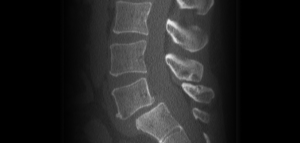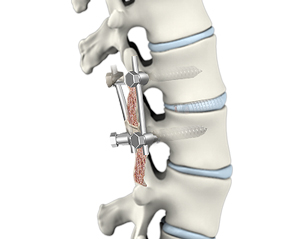 What is Spondylolisthesis?
What is Spondylolisthesis?
Spondylolisthesis is a spinal condition in which a vertebra slips forward over another vertebra beneath it. This slipping effect can put pressure on your spinal nerves, which will cause lower back pain or leg pain. In many cases non-surgical treatment is enough to resolve the issue, but if the spondylolisthesis symptoms are severe surgery will be considered as part of your treatment plan. Spondylolisthesis surgery is generally a very successful procedure to resolve back and leg pain.
Degenerative Spondylolisthesis
Spondylolisthesis can be caused by the general aging process, which makes it degenerative. Over time the bones, joints and parts of the spine become weaker and less able to keep the spine properly aligned. The risk of having degenerative spondylolisthesis increases with age, being more common in people over 50 and significantly moreso in people over 65. Females are also 3 times as likely to be effected by this condition. The most common location in the spine is L4-L5 spondylolisthesis, with the L3-L4 level the second most common. These areas of the spine are in the lumbar region, which is the lower back.
 Spondylolisthesis Symptoms
Spondylolisthesis Symptoms
It’s possible to live with spondylolisthesis for years with no symptoms, particularly if you have low grade spondylolisthesis. If you’re experiencing symptoms, the most prominent one is lower back pain which may radiate down your thighs. More possible symptoms include muscles spasms in the back of the thighs, back stiffness, difficulty walking for long periods, pain when bending over, and numbness, weakness or tingling in the foot.
What are the types of spondylolisthesis?
We’ve already mentioned one type of spondylolisthesis, which is the degenerative type caused by aging. There are other types of spondylolisthesis however, like congenital spondylolisthesis which happens when a baby’s spine doesn’t form the correct way and because of this it puts the person at higher risk for a slipped vertebra later in life. Isthmic spondylolisthesis is caused by a stress fracture in part of the spine that contributes to the spinal vertebra to slip forward.
 Spondylolysis vs Spondylolisthesis
Spondylolysis vs Spondylolisthesis
Though they sound a little similar and are linked in a way, there is a major difference between the two. Spondylolysis is the stress fracture of the pars interarticularis bone on the back of the spine, which is the weakest part of the spine. There are many causes of spondylolysis such as a car accident, repetitive extension of the spine in gymnastics, a fall, or degenerative changes. When spondylolysis causes spondylolisthesis it’s called isthmic spondylolisthesis as mentioned previously. The fracture in the weak part of the spine makes vertebra slippage more likely, which is why spondylolysis should be treated early on so it doesn’t progress.

Grade 1 to Grade 5 Spondylolisthesis
Spondylolisthesis is classified into grades, depending on how far the vertebra has slipped forward in the spine. Grade 1 is the lowest grade and is marked as being about 25 percent slipped forward. Grade 2 is between 25-50 percent forward. Grades 1 & 2 likely do not require surgery, but rather non-surgical treatments and monitoring by a doctor to make sure things don’t get worse. Grades 3 & 4 are a little more serious and might require surgery if you’re having severe symptoms. They are 50-75 percent, and 75-100 percent slipped forward respectively. The final grade is Grade 5, which means the vertebra has completely fallen off and looks to be detached, which is very rare.
Non-Surgical Treatments for Spondylolisthesis
If you have Grade 1 or 2 spondylolisthesis usually the approach to recovery is non-surgical. Medications to take while recovering can be over the counter pain medications like acetaminophen, or NSAIDs like ibuprofen. Oral steroids can also help reduce inflammation in the lower back. Heat and ice can also be applied to the back to relieve pain, and relax muscles while promoting blood flow to hasten healing. Physical therapy is recommended during recovery, utilizing stretching to alleviate stress on the lower back. A physical therapist can assist in guiding you with an appropriate exercise routine that is safe for your back, while aiding in strengthening appropriate muscles. Another non-surgical approach is chiropractic manipulation by trained health professionals who can help reduce pain.
Epidural steroid injections for spondylolisthesis can be very effective by decreasing inflammation and reducing pain. The pain relief experienced after an epidural injection helps patients progress with the non-surgical approaches such as physical therapy and manual manipulation.
 Spondylolisthesis Exercises
Spondylolisthesis Exercises
Working with a physical therapist is crucial when recovering from spondylolisthesis, because they give you an evaluation to determine what exercises will help lower your pain levels. If you push yourself too far or too hard during recovery, it can make your back issues worse. The types of exercises recommended during training are lumbar flexion exercises, core stabilization exercises, and stretches for the muscles of the back, hamstrings, and hips. Cycling and swimming are also good since they are low impact. A few specific exercises that may help are the pelvic tilt, crunches, and hamstring stretch. Since people with spondylolisthesis have spinal instability it can cause tension on the hamstrings, which then pull on the lower back causing a cycle of pain. Stretching your hamstrings will help prevent this, and help in the path to being pain free.
Spondylolisthesis Surgery
 When the pain has progressed enough, or the severity of the spondylolisthesis is far enough along surgery will be considered to fix the vertebra. Non-surgical approaches will usually be tried first, but if they aren’t having the desired outcome, surgery is the next step. The primary surgery to treat spondylolisthesis is called a lumbar interbody fusion. There are a few approaches to doing a lumbar interbody fusion like the XLIF, ALIF, TLIF, and PLIF. The differences are based which side you approach the surgery from, the front, back, or side. ALIF means anterior, or the front, PLIF is posterior or the back, and TLIF is transforaminal which is the side. XLIF is a minimally invasive approach from the side using only a small incision to perform the lumbar fusion. Fusion in the spine involves grafting a bone between two vertebrae and stabilizing the graft using metal plates and screws to ensure the graft fuses successfully. There will also be a decompression to relieve pressure on the nerves in the spine, and depending on the cause different surgeries will be performed. Herniated discs will require a discectomy to remove a part of the disc, while a narrow foramen requires a foraminotomy which makes more room for the nerves.
When the pain has progressed enough, or the severity of the spondylolisthesis is far enough along surgery will be considered to fix the vertebra. Non-surgical approaches will usually be tried first, but if they aren’t having the desired outcome, surgery is the next step. The primary surgery to treat spondylolisthesis is called a lumbar interbody fusion. There are a few approaches to doing a lumbar interbody fusion like the XLIF, ALIF, TLIF, and PLIF. The differences are based which side you approach the surgery from, the front, back, or side. ALIF means anterior, or the front, PLIF is posterior or the back, and TLIF is transforaminal which is the side. XLIF is a minimally invasive approach from the side using only a small incision to perform the lumbar fusion. Fusion in the spine involves grafting a bone between two vertebrae and stabilizing the graft using metal plates and screws to ensure the graft fuses successfully. There will also be a decompression to relieve pressure on the nerves in the spine, and depending on the cause different surgeries will be performed. Herniated discs will require a discectomy to remove a part of the disc, while a narrow foramen requires a foraminotomy which makes more room for the nerves.
Spinal surgery for spondylolisthesis is a serious decision, so you’ll want to discuss the risks, advantages and possible complications of any surgery you undertake. You’ll also want to know the recovery process and how long it might take. Generally spinal fusion surgery types take a few months up to a year to recover from, which will be supplemented with physical therapy. Talk to a doctor if you’re experiencing lower back pain, and need a diagnosis to find out if it’s spondylolisthesis or a variety of other back ailments that may cause back pain.


